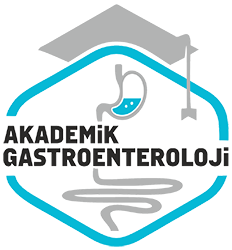Nisan 2016
Siroz ve tümör disi portal ven trombozu; risk faktörleri, klinik ve laboratuvar özellikleri
Non-cirrhotic non-tumoral portal vein thrombosis: risk factors, clinical and laboratory manifestations
- Ana Sayfa
- Sayılar
- Nisan 2016
- Siroz ve tümör disi portal ven trombozu; risk faktörleri, klinik ve laboratuvar özellikleri...
Özet
Giriş ve Amaç: Klinigimizde tanı alan siroz ve tümör dışı portal ven trombozlu hastalarimizin etiyolojik, klinik ve laboratuvar özelliklerini sunmaktir. Gereç ve Yöntem: Dicle Üniversitesi Tıp Fakültesi Gastroenteroloji Klinigine Mayis 2010- Agustos 2011 tarihleri arasında basvuran, siroz ve tümör tanısı dislanmis portal ven trombozlu 25 hasta retrospektif olarak incelendi. Hasta kayitlari demografik özellikler, başvuru semptomları, laboratuvar, radyolojik ve endoskopik özellikleri açısından tarandi. Bulgular: Olgularimizin 16’si kadın, 9’u erkek olup ortalama yaş 39,4±13,1 (17-71) idi. En sık başvuru yakinmasi karın ağrısı (%44) olup En sık rastlanan fizik muayene bulgusu splenomegali (%76) idi. On hastamizda majör etiyolojik faktör saptandi. Bir hastada iki, bir hastada ise üç etiyolojik faktör birlikte mevcuttu. Olgularin %32’sinde metiltetrahidrofolat redüktaz gen mutasyonu (1 hastada homozigot, 7 hastada heterozigot), %16’sinda gebelik/postpartum dönem, %12’sinde splenektomi öyküsü, %8’inde polisitemia rubra vera, %8’inde myelofibrozis ve %4’ünde JAK-2 gen mutasyonu saptanmıştır. Üç olgumuz akut, 22 olgumuz kronik portal ven trombozu tanısı almıştır. Sonuç: Portal ven trombozu tanıli hastalarimizda En sık görülen etiyolojik faktörlerin, kronik myeloproliferatif hastalıklar ve gebelik olduğu saptandi. Portal ven trombozunda etiyolojik faktörün saptanmasi tedavi plani ve progresyonun önlenmesi açısından önemlidir.
Abstract
Background and Aims: The purpose of this study was to present etiological, clinical and laboratory manifestations in patients diagnosed with non-cirrhotic non-tumoral portal vein thrombosis in our clinic. Materials and Method: A total of 25 patients who had been diagnosed with non-cirrhotic non-tumoral portal vein thrombosis in the Gastroenterology Clinic of Dicle University Faculty of Medicine between May 2010 and August 2011 were examined in this study retrospectively. Demographic data, presenting symptoms and laboratory, radiological and endoscopic manifestations were noted. Results: Of 25 patients with a mean age of 39.4±13.1 years (ranging from 17 to 71), 16 were female and 9 were male. The most common presenting symptom was abdominal pain (44%), and the most common physical examination finding was splenomegaly (76%) among these patients. Ten patients exhibited some kind of major etiological factor -one patient exhibited two factors and another patient exhibited three factors concurrently. In addition, 32% of the patients had methylenetetrahydrofolate reductase gene mutation (homozygous state in 1 patient and heterozygous state in 7 patients). Sixteen percent of the study population was comprised of postpartum patients, 12% had a history of splenectomy, 8% had polycythemia rubra vera, 8% had myelofibrosis and 4% had JAK-2 gene mutation. Three patients were diagnosed with acute portal vein thrombosis and 22 patients were diagnosed with chronic portal vein thrombosis. Conclusion: The most common etiological factors identified in our patients were myeloproliferative diseases and pregnancy. In this respect, determination of the etiological factor underlying portal vein thrombosis is of importance both for halting the progression and planning the treatment.



